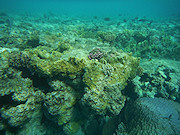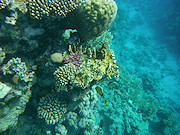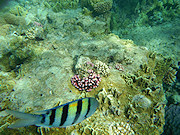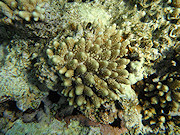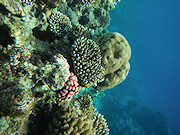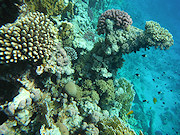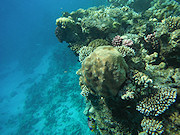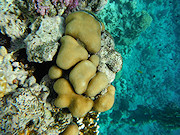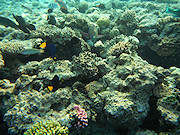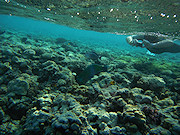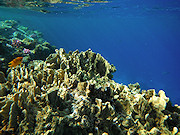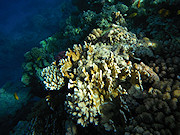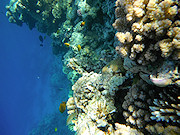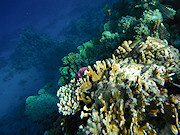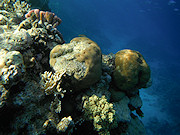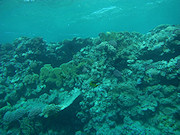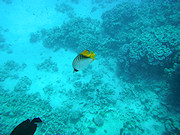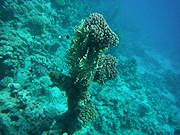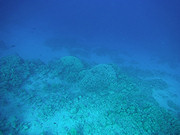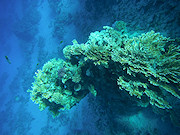Underwater cameras test 2011
2. Fujifilm FinePix XP30
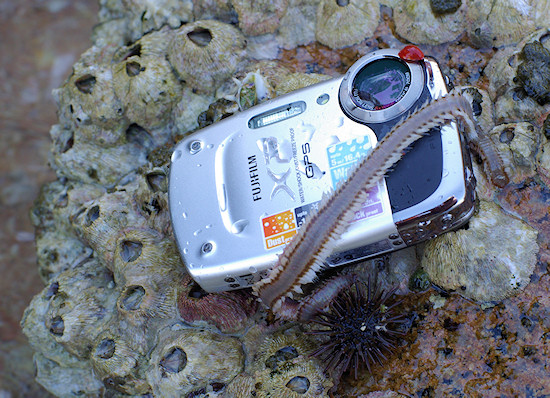 |
At the beginning of January the Fujifilm company showed two new representatives of the FinePix XP underwater compact segment. The design and style of the FinePix XP20 and the FinePix XP30 show they are clearly the continuation of the series, both of them being twin models differing only in the GPS receiver, added to the latter. The comparison of parameters between the new models and the XP10 camera, launched last year, shows that the producer decided to use new, stabilized sensor with a resolution increased to 14 Mpix. Unfortunately it influenced the efficiency of the burst mode which now allows you to take photos only as fast as barely 0.8 fps.
Other changes seem to be more wellgrounded because in new FinePix devices we find a wide-angle lens which equivalent of focal lengths starts from 28 mm and the aperture which value starts from f/3.9. The optical zoom ratio didn’t change so the maximum focal length available is 140 mm. The camera was given an SDXC memory cards support and, what is the most important thing, the casing was reinforced. Although the producer declares that the same norms are met (IP68– fully dust-proof, IPX8 waterproof, MIL-STD-810F-516.5 shock-proof) as in the case of the XP10, further on it is stated that the XP20 and XP30 models allow you to take pictures at the depth of 5 m during 120 minutes and the casing will resist a fall from a height of 1.5 m.
Please Support UsIf you enjoy our reviews and articles, and you want us to continue our work please, support our website by donating through PayPal. The funds are going to be used for paying our editorial team, renting servers, and equipping our testing studio; only that way we will be able to continue providing you interesting content for free. |
- - - - - - - - - - - - - - - - - - - - - - - - - - - - - - - - - - - - - - - - - - - - - - - -
Of course the weight and dimensions were influenced by those changes – the XP30 is bigger and by several dozen grams heavier than the participant of the last year’s test. Other parameters by and large were left unchanged – in the tested camera you can find a similar 2.7-inch 230K-dot LCD screen, covering 96% of the frame; the shutter speeds are within the same range, starting from 1/2000 s., and the video mode allows you to shoot HD resolution videos in the resolution of 1280×720 pix at 30 fps in the AVI format (Motion JPEG) and with mono sound.
Design and build quality
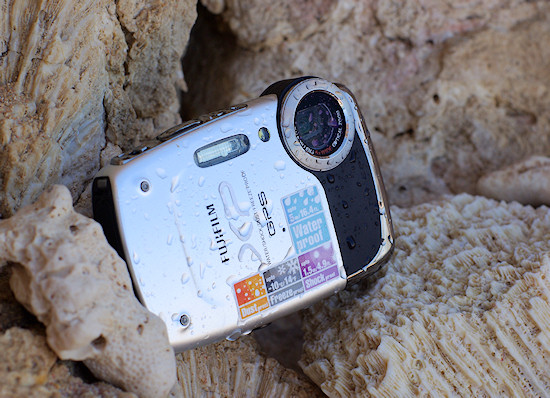 |
The Fujifilm XP30 is very solidly built. The whole casing is stiff, compact, its elements – well-fitting, its buttons - without any redundant slack. Metal plates, made most likely of aluminum, occupy most of the front, upper and bottom surfaces. On the side panel, housing a little loudspeaker, you can find an element made of hard, quite smooth plastic but the rest of the construction (the back and the other side) consists of elements made of quite soft or rubberized plastic; add to it a thumb inset and an appropriate perforation and you get a camera which can be comfortably and safely held in your hand.
On the side panel of the camera there are two sealed covers. The first and the bigger one hides a storage battery NP-45 and a memory card port. You have to open it to get to the second cover, the smaller one, behind which you can find and USB 2.0 High-Speed port acting also as a video output.
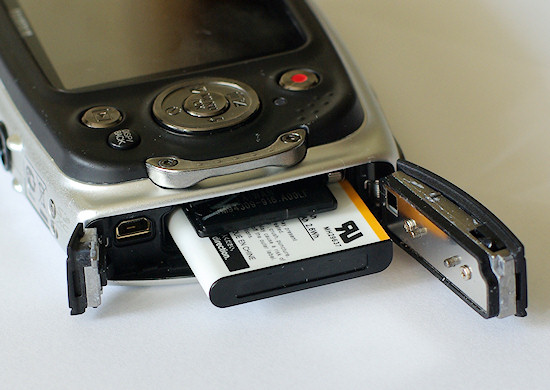 |
All elements under these plates are set quite deep inside. As it is not a big problem in the case of the USB port, people with massive fingers or/and short fingernails might experience some difficulties when it comes to the memory card and battery. It is a standard procedure to push the memory card a bit in before pulling it out – some users might find it an impossible task here, at least without using an additional tool.
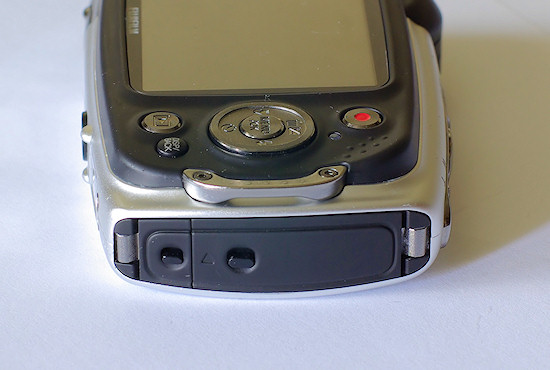 |
Similar problem you can encounter while opening the plates because levers you are supposed to use are small and practically don’t stick out. If you think about operating the XP30 it might be a good idea to grow your fingernails a bit. The bad news is that you can break them easily while closing the bigger plate - it does demand a lot of strength and you must put all your effort into this task to hear that characteristic click, which confirms no water will seep inside.
The constructors of the new FinePix made several changes in the layout of buttons, compared to its older XP10 version. In our opinion they made operating of this camera better – W and T buttons, previously positioned under your thumb, now are replaced by a little lever on the upper wall next to the shutter release. In their place a thumb inset was added, to make a comfortable place for your finger, and a big button starting the video mode.
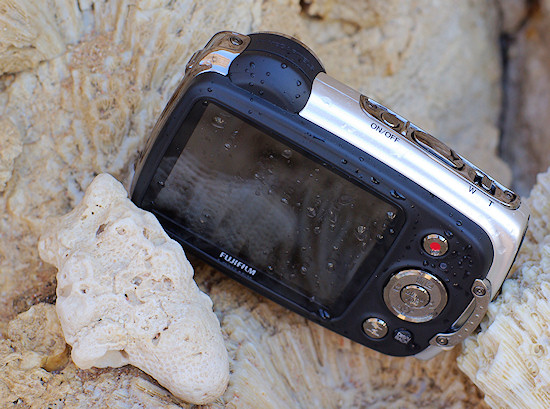 |
On the back panel you can also find the MENU/OK button, surrounded by a four-way controller which, additionally, gives you a speedy access to the macro mode settings, exposition compensation, delayed-action release and a flash. Below you can also find the switch starting playback mode and DISP/BACK button, making you return to the previous menu level and change information displayed on the LCD screen.
At the end of this section we should mention a tripod socket, situated almost in the middle of the bottom panel and the ON/OFF switch, positioned centrally on the top.
Use, cleaning, wear and tear
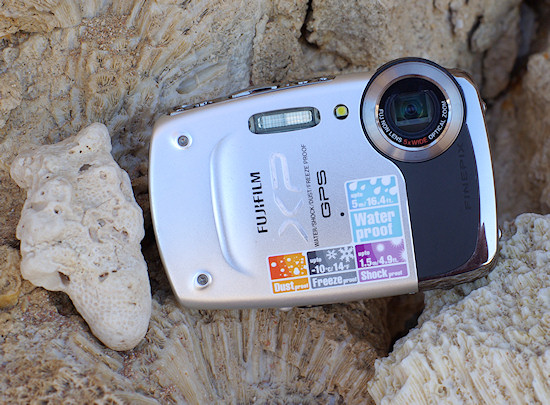 |
The FinePix XP30 is not as easy to clean as its predecessor but among the tested five devices it still stays at the top. You can find several nooks and crannies where salt can be deposited if you don’t rinse the camera right after going out of the sea. We think here especially about the ring surrounding the lens and the edges of the rear plate. We did notice one alarming thing, though. Several dozen minutes after diving, when the camera seemed to be completely dry, while taking photos we noticed water coming from under the playback mode button. Probably it gathers below the plastic element put around the LCD screen. Unfortunately we didn’t find out how to solve/prevent that problem.
The specimen we got certainly had already been tested in several other editorial offices or/and showed during many demonstrations and fairs. Despite the fact that at least 1,500 photos had been taken with it and we added next 500 to that count during our test, you couldn’t find many tear and wear marks on its casing. All we could see were slight grooves on the front panel.
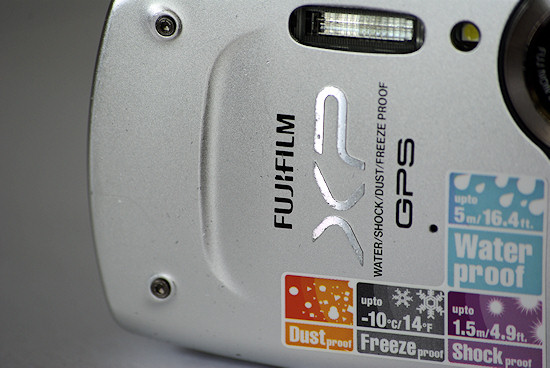 |
You should also praise the quality of its LCD screen protecting window. Some people had used it previously and we tested it for a week; the camera had contact with sand and rocks several times, as we positioned it on them to take photos; still the number of scratches on the LCD screen remained low and their superficial character doesn’t cause any discomfort during the usage.
Additional functions
The Fujifilm FinePix XP30 was equipped with an GPS receiver. Its initiation takes about a minute but after that time it indicates your location without any problems, either in Poland or in Egypt. Of course under water or in a building you can’t count on a good signal reception.The GPS can work in continuous mode (even when we switch the camera off) or only after switching the camera on. You can also switch it off completely. The producer planned the function of tracking, so logging data concerned your actual position to a file saved in a memory card. Because of that option the MyFinePix Studio program can show you your route later.
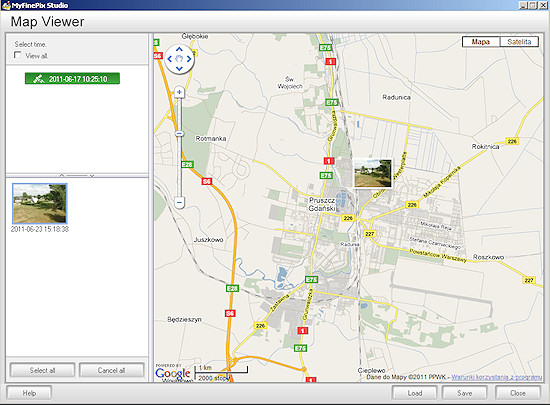 Location indication of the place in Poland where the picture was taken, shown in MyFinePix Studio |
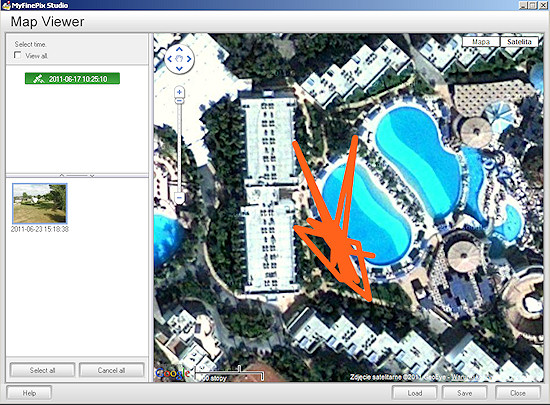 Indication of a route taken with the camera in Egypt |
Apart from that, when we have the GPS module switched on and we browse photos with saved information about the location in the playback mode the camera will indicate an approximate direction and distance from the place a given photo was taken. It is clear that Fujifilm constructors offered a really functional tool which will come in handy if you like taking photos during a travel.
The next interesting feature is the possibility of shooting panoramic photos. Unfortunately that function doesn’t work like in the case of e.g. FinePix HS20, where it was enough to move the camera from left to right (or the other way round) with the shutter release pressed and you got a ready panorama in a second or so. In the XP30 it was solved in a different way. After choosing the panoramic mode and taking the first photo a viewfinder appears and we have to fit it in the right place, indicated in the new frame. When we manage to do so, the camera will take the next photo on its own. This process must be repeated once again and then the XP30 will create a panorama based on these three frames. The whole procedure is quite troublesome and takes more than a dozen seconds but the result can be quite satisfying.
 Click to enlarge. |
Unfortunately we can only dream about underwater panoramic photos - that function works only when the image is static; otherwise, the camera have problems with matching the photos correctly.
Underwater usage
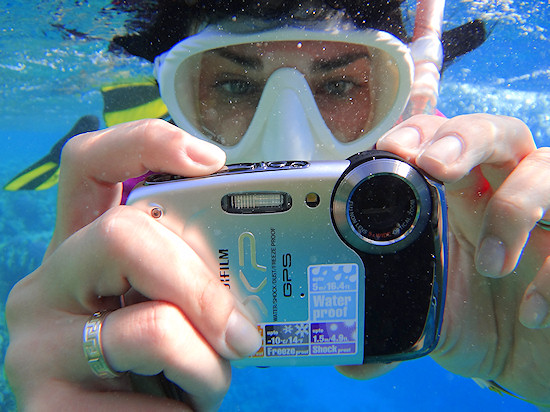 |
Traditionally, starting the underwater mode in the Fujifilm is complicated – you have to enter the menu and browse your way through a long vertical list of thematic modes. In the case of the XP30 it is even more difficult because this time the producer included three thematic underwater modes.
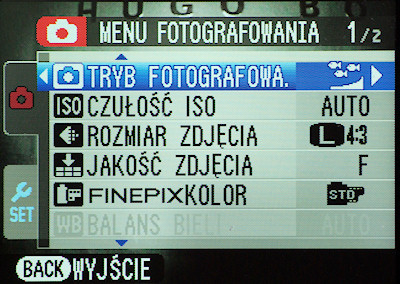 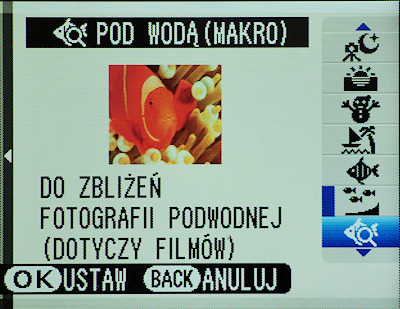 |
The first one is „Underwater” mode, known from the previous versions; the new ones are “Underwater (wide-angle)” for wide-angle underwater pictures and “Underwater (macro)” for close-ups.
Switching between the modes is quite bothersome – you have to enter the main menu, press the four-way controller to the right, enter the photographic mode menu and then choose (up-down arrows) the appropriate mode and approve it pressing the OK button. Regrettably everything lasts a long time and is not worth all the bother. The differences between particular modes are very slight – the one thing that changes is the exposure (a comparison below), or the macro mode for autofocus is switched on. We must add that both autofocus and the exposure in the tested Fuji like playing tricks.
| Picture taken in the „Underwater” mode | |
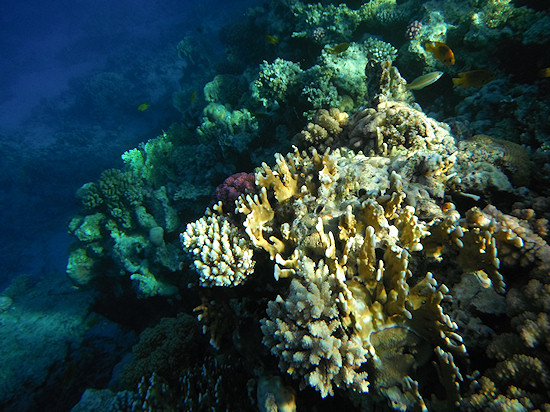 |
|
| Picture taken in the „Underwater (wide-angle)” mode | |
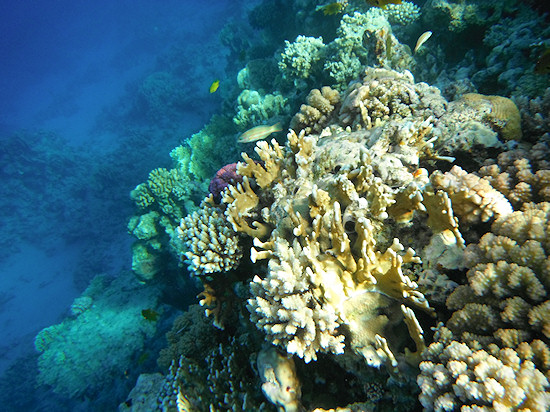 |
|
Automatic focusing in the XP30 is the slowest of all cameras, tested this year. As a result, when you snorkel in rough sea you must take into account the fact that about 50% of your photos, taken with the XP30, will be blurry because the camera’s focusing can’t keep up with a situation when the distance to the photographed object changes quickly and constantly.
The light metering is nothing to be optimistic about either – in fact it is fully unpredictable. Taking photos one after the other of the same scene we might get a different frame exposure every time. In order not to sound groundless we present below eight photos of the same scene, taken at 2-3 second intervals.
| Random light metering in Fujifilm XP30 | |
 |
 |
 |
 |
 |
 |
 |
 |
In order not to appear overly critical we left some positive aspects at the very end. Firstly, that dedicated button for video mode was certainly a good idea. Its position is much better than in the previous model as it allows to start and finish recording very quickly. Video recording begins almost immediately – we don’t have those irritating delays while passing from photographic to video mode. As we mentioned earlier, substituting impractical W and T buttons with a zoom lever, set next to the shutter release, was a splendid solution. Although it is small and quite slippery, it was certainly one of good decisions taken by the constructors. Also the same design of buttons and their stop make the XP30 a joy to use. Some reservations you can have when it comes to the shutter release – although it is big, its first stop, starting the autofocus, is too weakly felt.
Next good decision was about adding to the camera a wrist strap with a toggle – you don’t have to worry that it will slip off during swimming. Perhaps it is not as comfortable a solution as a neoprene band, available with the XP10, still it should be considered an advantage.
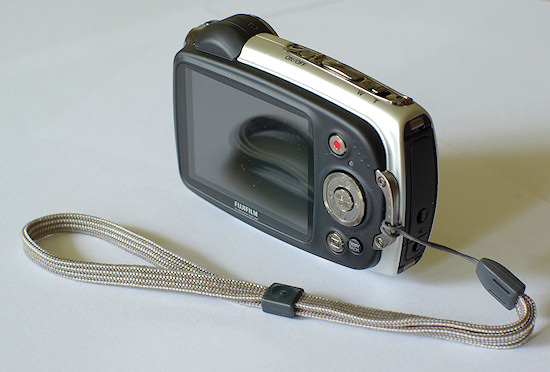 |
As we’ve already mentioned, the XP30 is stylistically close to earlier, waterproof Fujifilm cameras with the lens situated on the side, hidden behind a protective window and a bit protruding over the upper plate – a very characteristic feature. Most probably that protruding of the lens was a reason why we haven’t managed to cover it with our finger even once during the test, something that is often a plague of many other cameras with similarly positioned lenses. If you consult the photo, published at the beginning of the subsection, you will notice that the fingers are spread quite naturally on the casing of the camera in such a way that eliminates any possibility one of them slipping and obscuring the view.
We dived mainly at 5 m with this camera because, according to its technical specifications, it is its maximum depth. However, sometimes we crossed that limit, especially during tests in the lake, where platforms, on which we stood taking the photos, were positioned at 7 m below the surface. The XP30 was neither damaged nor flooded but we must admit that below 5 m the operation of the camera is becoming more difficult or even impossible - the water pressure can press some buttons down without us being aware of it. After switching the camera on often the info about the version of firmware was displayed– it happens only when you switch the camera on while pressing DISP button at the same time and we certainly weren’t doing it. When finally we managed to start the XP30 properly we could only take photos, the video mode didn’t want to work at all. Of course you can’t consider it a flaw – according to the specifications up to a depth of 5 meters you won’t experience such inconvenience.
Finally a word or two about the LCD screen. In the previous section we praised its protective window but now we must also criticize it a bit. Although it is scratch-resistant, it makes the image on the screen hardly readable in blazing sun, especially that the screen highlighting is not exactly bright either. Of course we can always see what we are trying to shoot but in this category the FinePix XP30 is placed definitely near the bottom of the whole group.
Underwater photos and videos quality
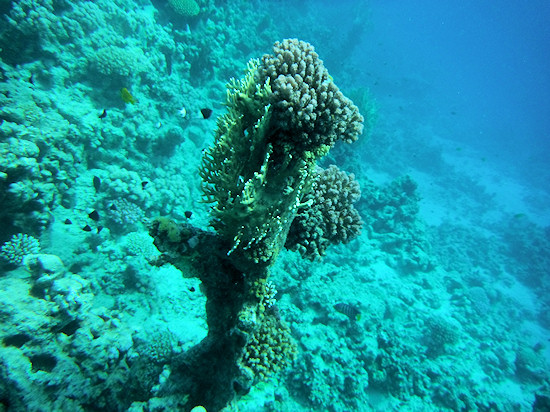 |
The quality of underwater photos, taken by the FinePix XP30, is mostly determined by its autofocus and exposure problems, which we described in the previous subsection. When you finally gather those pictures in which the AF system worked correctly, you’ll find them fuzzy and not rich in detail, especially if displaying them in their full resolution. The sharpness decreases as you move towards the corners of the frame – a very clear proof that the optics, used in this camera, is far from perfect, deteriorating the quality of images.
The colours of the photos also leave a lot to be desired. Sometimes the images look as if they were taken in cold, greenish waters which coral reef has been long dead because of low temperatures. It happens the most often when the light is not favourable – the sun shining from the sea on the shallow part of the reef. Even when the direction of sunlight is advantageous for the colours of the underwater world, we must take into account the fact that with the photos taken toward the depth of the sea (sun shining from the shore) the results will remain unpredictable due to the exposure problems. The blue hue of water can be alternatively too pale or too dark, bordering navy blue.
A bit better situation we witnessed for images taken at greater depths – those photos featured the correct exposure. Unfortunately the autofocus experienced more problems then, due to lack of light. As a result the images were even more fuzzy and less detailed. Colours also don’t enrapture you with their vividness; already several meters below the surface the blue dominant makes itself felt and the pictures are devoid of natural hues.
When it comes to videos, the situation is similar. When the sea is rough the autofocus doesn’t keep up with the changes of distances to the object you are trying to register so it misses quite often. Detail rendition is on an average level, offered by the Motion JPEG coding but significantly lags behind the possibilities of AVCHD. Especially those scenes which are quite dynamic lack the right image flow because of lossy compression and recording at a speed of just 30 fps.
The colours of video clips are close to those of images the XP30 offers in the photographic mode. If the light is favourable we can see hues similar to natural ones but it’s enough the sun is on the wrong side and the coral reef is rendered as green-blue. When you dive, already at the depth of about 3 meters the image becomes dominated by the blue hue.
As if it wasn’t enough, the XP30 tackles the same problems as those experienced by the XP10. We think here about the full loss of focus during focal length change and an irritating zooming sound, which is recorded on the videos.
At the end some words about the usage of the XP30 in green waters of the lake, where the visibility during our tests was limited to 2 m. At a depth of 5 m the amount of light in such conditions is small indeed – no surprise we experienced even greater autofocus problems and, as a result, the camera often informed us that finding focus was impossible. In most situations, even when the AF system signaled successful focusing, the images turned out blurred anyway. Their colours also left a lot to be desired – they green colour dominates all the rest.
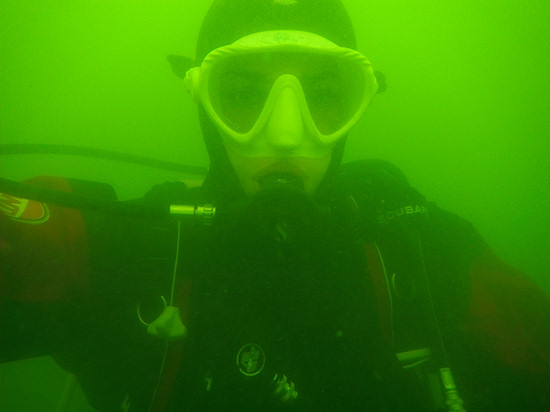 A photo taken in a lake at a depth of about 6 m with visibility of 2-3 m. Click to enlarge. |
Summary
First let’s consult the pros and cons list of the tested camera.
-
Pros:
- scratch-resistant LCD screen,
- good location of the lens, making it impossible to cover it accidentally with your finger,
- quick start of video recording mode,
- correct colouring of dry land photos taken in the underwater mode,
- satisfactory colouring of dry land videos recorded in underwater modes,
- functional strap added in the box,
- well-profiled shape of the casing and a big shutter release button,
- functional GPS module.
- no HDMI port,
- not very efficient battery,
- barely palpable first stop of the shutter button,
- waterproof only to 5 m,
- LCD screen not legible against bright light,
- thematic modes hidden deep in the vertical menu,
- very slow and not accurate autofocus,
- slow focusing after focal length change in video mode,
- audible zooming mechanism – it sound is registered on videos,
- underwater pictures not very detailed,
- not very vivid colouring of pictures and underwater movies,
- pictures and movies recorded at greater depth with strong blue dominant,
- pictures taken in the lake are showing strong green hue,
- problems with light metering,
- inconvenient port plates.
Cons:
Fujifilm underwater cameras have never been given very high scores in our tests. However you must remember that they have always been products definitely cheaper than the rivals so in our summaries we’ve always had something positive to say about them. It would be most probably the same in the case of the tested camera here if it wasn’t for the aforementioned autofocus and light metering problems. These are flaws difficult to forgive and we can only hope that they concern only the single specimen tested by us.
Apart from that you have to admit the Fujifilm constructors took several accurate decisions. They offered a camera with a lens featuring more functional focal lengths’ range, changed the location of buttons and controllers making the device more user-friendly. It would be a good thing if they thought about restructuring the thematic mode menu in the next model, saving us the drudgery of getting through several dozen vertical menu options. Instead of offering additional underwater modes, which anyway are difficult to change while diving, they could also think about improving the white balance so the underwater images have the proper colouring.
Underwater video samples
| Motion JPEG AVI, 1280×720 pix, 30 fps, 12 s, 33.7 MB |
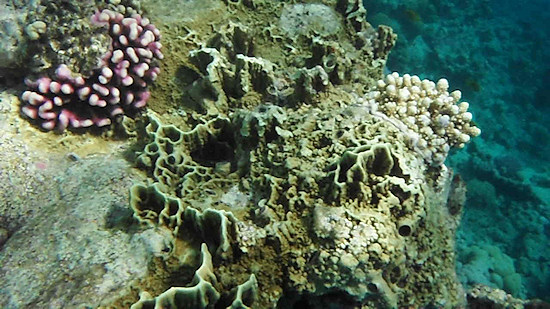 |
| Motion JPEG AVI, 1280×720 pix, 30 fps, 19 s, 53.5 MB |
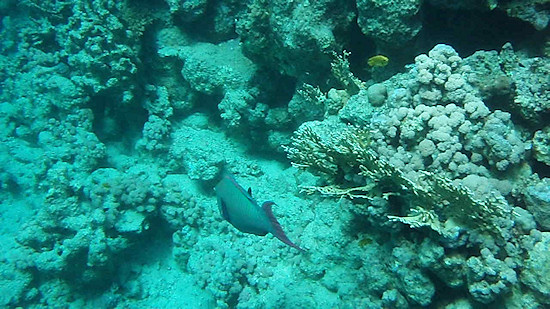 |
| Motion JPEG AVI, 1280×720 pix, 30 fps, 26 s, 73.1 MB |
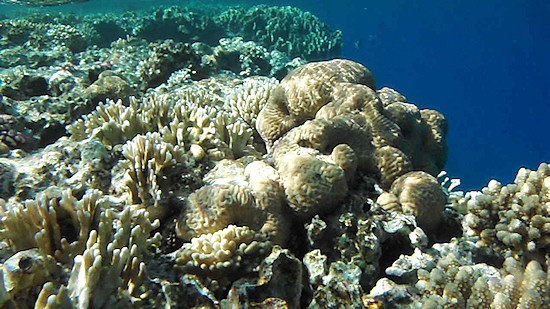 |
Sample underwater shots




